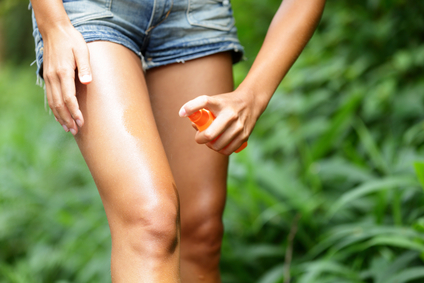Is DEET a Good Insect Repelling Option?
Posted by Katie Zapotoczny on 2nd Jul 2015

Summer is in full swing, and so are the bugs. To combat insects, many people reach for products containing N,N-diethyl-meta-toluamide, or DEET, for short. DEET is recognized as an effective insect repellant, but the use of DEET carries a number of potential health risks.
Because some insects can spread illnesses that may pose serious threats for sensitive or vulnerable groups, finding an effective way to repel disease-carrying insects can be very important. DEET, however, may not be the best answer.
Health Concerns Related to Biting Insects
There are a number of concerns associated with biting insects. For one thing, it often hurts to get bitten, and the site of the bite can become swollen and itchy. Some people tend to attract bugs more than others. So for those whose skin seems to shout “over here, over here!” to mosquitos and other bugs, finding a way to deter them really is important.
Biting bugs can also carry and spread diseases, including West Nile virus, which is carried by mosquitos, and Lyme disease, which is transmitted by ticks. West Nile virus mainly affects people over the age of 50 and those with compromised immune systems. Fortunately, most people who are infected with this virus don’t develop any symptoms. Some people, however, may have headaches, joint pain, fever, vomiting, diarrhea, and a rash. In rare cases, the virus can infect the area around the spinal cord, leading to coma, paralysis, and even death. If you have concerns about West Nile virus in your area, you can check this map from the Centers for Disease Control and Prevention to see if you live in a location that has high West Nile virus activity.
Lyme disease is a bacterial infection carried by ticks. Symptoms include fever, headache, fatigue, and a rash. Because it is caused by bacteria, Lyme disease can be treated with antibiotics. Most people, though, would probably prefer to avoid Lyme disease rather than have to treat it.
Because such diseases can be transmitted by biting insects, taking precautions to avoid these bugs can be very important.
Is DEET a Safe Option?
DEET was first developed for the U.S. Army and was approved for consumer use in the 1950s. It is known to be an effective insect repellant. When it is used as directed, DEET is actually considered safe by many public health organizations, including the Environmental Protection Agency, the Centers for Disease Control and Prevention, the American Academy of Pediatrics, and the World Health Organization. I was surprised to learn two years ago that even the Environmental Working Group recommends the use of DEET. Although they do stress that consumers should use it with caution and in the lowest effective concentrations (source). The EPA reviewed DEET’s safety record in 1998 and again in 2014 (source). The agency concluded that it was safe after both reviews.
Although the general consensus of these health organizations is that DEET is safe when used properly, there are still reasons to be wary of it. To begin with, DEET is infamous for its ability to damage plastic, rubber, and vinyl (source). A product that can damage such materials is likely not one that you want to put on your skin.
DEET is available in the U.S. in concentrations ranging from around 5% all the way up to 100%. Yes, 100%! But higher concentrations don’t necessarily mean increased protection from insects. The concentration relates to how long you will be protected against bugs, not how effective the product is. If you’re going to be outdoors for a couple of hours, then a concentration of 7-10% is recommended. For all day protection, 20-30% will work (source). Levels above 30% simply are not necessary, and can be toxic as well. Interestingly, insect-repelling products sold in Canada are required to contain no more than 30% DEET.
DEET has been linked to memory loss, headaches, muscle weakness and fatigue, shortness of breath, joint and muscle pain, and tremors (source). Lab rats also exhibited behavioral changes and even death with prolonged or frequent exposure (source).
Some of the adverse reactions that result from the use of DEET occur when it is used in higher concentrations, or when it has been applied for several days in a row (source). For example, it can cause allergic skin reactions and eye irritation at concentrations of 50% or above. DEET has also been known to cause seizures, slurred speech, and coma. These symptoms generally occurred in people who ingested DEET, applied it for three or more days in a row, or used products with 95% DEET or more. The safety record of DEET- especially at higher concentrations- is questionable at best. Children, seniors, and those with weakened immune systems also appear to be particularly vulnerable to the side effects of DEET. And children's thinner skin allows for more of this synthetic chemical to be absorbed into their bodies.
The Best Ways to Protect Yourself From Bugs
There are times and places when it is critical to keep insects at bay. However, there are many options for keeping bugs away that are much safer than DEET:
* Wear socks and long pants and sleeves whenever possible and especially in heavily wooded areas or areas with a lot of brush; tuck long pants into your socks to help keep ticks off of your skin.
* Don’t wear tight clothing; mosquitos can get trapped inside them.
* If possible, stay indoors in the morning and evening, when mosquitos are most active.
* Use nets and/or fans around outdoor eating areas.
* Cover strollers and baby carriers with nets.
* Avoid fragrances, which can attract bugs.
* Plant mosquito-repelling plants such as geraniums, lemon thyme, marigolds, sweet basil and/or sassafras near your home.
* Remove standing water (think bird baths, kiddies pools, gutters, flowers pots, pet dishes, etc.) that can attract bugs.
* Repel bugs with diluted essential oils (lavender, peppermint, eucalyptus, clove, and tea tree are all good options) or with Verefina Bug Defense. This 100% natural formula is made with essential oils that are known to repel insects.
Conclusion
While DEET is an effective insect repellent, it certainly is not the safest one. It is particularly dangerous when used at high concentrations or for more than a few days in a row. In contrast, wearing protective clothing, creating an inhospitable environment for bugs near your home, and using essential oils are all much safer methods of keeping bugs away.
Sources:
Consumer Reports. “Chemical-Based Insect Repellents Work, But You May Want to Try Safer Alternatives.” The Washington Post. 23 June 2014. Web. 24 June 2015.
"DEET." The Environmental Protection Agency. Web. 29 June 2015.
http://www2.epa.gov/insect-repellents/deet
“EWG’s Do’s and Don’ts for Avoiding Bug Bites.” The Environmental Working Group. 17 July 2013. Web. 24 June 2015.
http://www.ewg.org/research/ewgs-guide-bug-repellents/ewgs-dos-and-donts-avoiding-bug-bites
Mercola, Joseph. “How to Prevent and Treat Insect Bites Without Harsh Chemicals.” Mercola.com. 22 July 2013. Web. 22 June 2015.
http://articles.mercola.com/sites/articles/archive/2013/07/22/insect-bite-treatment.aspx
“Repellent Chemicals.” The Environmental Working Group. 17 July 2013. Web. 24 June 2015.
http://www.ewg.org/research/ewgs-guide-bug-repellents/repellent-chemicals
Sharp, Renee. “100% DEET: Good Bug Protection or Bad Idea?” The Environmental Working Group. 23 July 2013. Web. 25 June 2015.
http://www.ewg.org/enviroblog/2013/07/100-deet-good-bug-protection-or-bad-idea
“West Nile Virus Activity by State- United States 2015.” The Centers for Disease Control and Prevention. 23 June 2015. Web. 29 June 2015.
http://www.cdc.gov/westnile/statsMaps/preliminaryMapsData/activitystatedate.html
Photo courtesy of Verefina
 About the Author
About the Author
Katie Zapotoczny is a Verefina Affiliate and the creator of An Ever Green Life, a blog that seeks to empower readers to make changes that will improve their health and help protect our environment.

